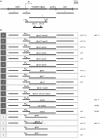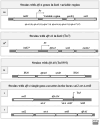Genetics of resistance to trimethoprim in cotrimoxazole resistant uropathogenic Escherichia coli: integrons, transposons, and single gene cassettes
- PMID: 38946902
- PMCID: PMC11213556
- DOI: 10.3389/fmicb.2024.1395953
Genetics of resistance to trimethoprim in cotrimoxazole resistant uropathogenic Escherichia coli: integrons, transposons, and single gene cassettes
Abstract
Cotrimoxazole, the combined formulation of sulfamethoxazole and trimethoprim, is one of the treatments of choice for several infectious diseases, particularly urinary tract infections. Both components of cotrimoxazole are synthetic antimicrobial drugs, and their combination was introduced into medical therapeutics about half a century ago. In Gram-negative bacteria, resistance to cotrimoxazole is widespread, being based on the acquisition of genes from the auxiliary genome that confer resistance to each of its antibacterial components. Starting from previous knowledge on the genotype of resistance to sulfamethoxazole in a collection of cotrimoxazole resistant uropathogenic Escherichia coli strains, this work focused on the identification of the genetic bases of the trimethoprim resistance of these same strains. Molecular techniques employed included PCR and Sanger sequencing of specific amplicons, conjugation experiments and NGS sequencing of the transferred plasmids. Mobile genetic elements conferring the trimethoprim resistance phenotype were identified and included integrons, transposons and single gene cassettes. Therefore, strains exhibited several ways to jointly resist both antibiotics, implying different levels of genetic linkage between genes conferring resistance to sulfamethoxazole (sul) and trimethoprim (dfrA). Two structures were particularly interesting because they represented a highly cohesive arrangements ensuring cotrimoxazole resistance. They both carried a single gene cassette, dfrA14 or dfrA1, integrated in two different points of a conserved cluster sul2-strA-strB, carried on transferable plasmids. The results suggest that the pressure exerted by cotrimoxazole on bacteria of our environment is still promoting the evolution toward increasingly compact gene arrangements, carried by mobile genetic elements that move them in the genome and also transfer them horizontally among bacteria.
Keywords: Escherichia coli; antibiotic resistance; cotrimoxazole; gene cassettes; integrons; plasmid transfer; transposons; trimethoprim.
Copyright © 2024 Poey, de los Santos, Aznarez, García-Laviña and Laviña.
Conflict of interest statement
The authors declare that the research was conducted in the absence of any commercial or financial relationships that could be construed as a potential conflict of interest.
Figures




Similar articles
-
Molecular Characterization of Cotrimoxazole Resistance Genes and Their Associated Integrons in Clinical Isolates of Gram-Negative Bacteria from Tanzania.Microb Drug Resist. 2017 Jan;23(1):37-43. doi: 10.1089/mdr.2016.0074. Epub 2016 Aug 17. Microb Drug Resist. 2017. PMID: 27533639
-
On sulfonamide resistance, sul genes, class 1 integrons and their horizontal transfer in Escherichia coli.Microb Pathog. 2019 Oct;135:103611. doi: 10.1016/j.micpath.2019.103611. Epub 2019 Jun 25. Microb Pathog. 2019. PMID: 31247256
-
Strict relationship between class 1 integrons and resistance to sulfamethoxazole in Escherichia coli.Microb Pathog. 2021 Dec;161(Pt A):105206. doi: 10.1016/j.micpath.2021.105206. Epub 2021 Oct 4. Microb Pathog. 2021. PMID: 34619311
-
The importance of integrons for development and propagation of resistance in Shigella: the case of Latin America.Braz J Microbiol. 2016 Oct-Dec;47(4):800-806. doi: 10.1016/j.bjm.2016.07.019. Epub 2016 Jul 26. Braz J Microbiol. 2016. PMID: 27528086 Free PMC article. Review.
-
[The role of integrons in dissemination of antibiotic resistance].Ann Biol Clin (Paris). 2000 Jul-Aug;58(4):439-44. Ann Biol Clin (Paris). 2000. PMID: 10932044 Review. French.
Cited by
-
Development and application of a highly sensitive quadruple droplet digital PCR method for simultaneous quantification of sulfonamide resistance genes.Front Microbiol. 2025 May 21;16:1612740. doi: 10.3389/fmicb.2025.1612740. eCollection 2025. Front Microbiol. 2025. PMID: 40469733 Free PMC article.
-
Temporal Trends of Escherichia coli Antimicrobial Resistance and Antibiotic Utilization in Australian Long-Term Care Facilities.Antibiotics (Basel). 2025 Feb 18;14(2):208. doi: 10.3390/antibiotics14020208. Antibiotics (Basel). 2025. PMID: 40001451 Free PMC article.
References
-
- Alcock B. P., Huynh W., Chalil R., Smith K. W., Raphenya A. R., Wlodarski M. A., et al. . (2023). CARD 2023: expanded curation, support for machine learning, and resistome prediction at the Comprehensive Antibiotic Resistance Database. Nucleic Acids Res. 51, D690–D699. 10.1093/nar/gkac920 - DOI - PMC - PubMed
LinkOut - more resources
Full Text Sources

